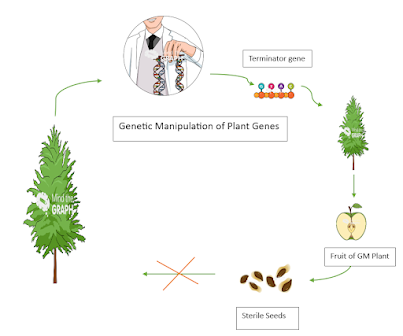TERMINATOR TECHNOLOGY
Definition: Terminator technology is a gene build
technology that involves genetic modification of a plant which leads to break
off the fertility of the stored seeds and results to an end of its
reutilization.
The genes involved in viability end
are called as Terminator genes OR Traitor genes.
These genes are responsible for
action in first generation or second generation.
How the Terminator technology work?
The first generation seeds (F1) are,
sold by the seed company, fully developed, normal and fertile to produce
healthy plants bearing seeds or fruits that can be used as food but will not
germinate if planted, which forces farmers to procure fresh seeds every year
from the seed company, because they cannot use the harvested seeds of the
previous year into the next season.
Production of Sterile Seeds:
The seeds were prepared at Farmer’s field
level and Seed company level. The plants cell first genetically manipulated
followed by their regeneration by Plant Tissue Culture, the mature plant
produced is T1, which produces T2 seeds which were sold to the market or
farmers. These seeds were not germinated in next season (Suicidal Seeds)
Terminator technology is the genetic
modification of plants to make them produce sterile seeds. They are also known
as suicide seeds. Terminator's the official name - used by the UN and
scientists - is also called as Genetic Use Restriction Technologies
(GURTs).
Terminator is thus the popular name
given to the Genetic Use Restriction Technology (GURT) that essentially shuts
off the reproductive abilities of seeds, making second generation seeds
sterile.
Meaning of GURT: Genetic Use Restriction Technology
(GURT) refers to restriction of any genetic trait in a plant that can be
switched on or off by the application of an external chemical inducer.
The trait may include colour, softening,
ripening, sterility, cold & drought tolerance etc.
Types of GURT:
1.T-GURT (Traitor technology,
trait-specific) refers to the restriction of a specific trait expression in a
plant.
2.V-GURT (Verminator
technology, variety specific) refers to restriction of the variety by genetic
engineering, plants whose seeds will not germinate if sown.
The terminator technology uses a
suitable lethal gene which makes the second generation seeds infertile or
non-viable.
Genetic basis of Terminator
technology:
Three stretches of DNA were need to
be introduced into plant.
The first strip of DNA has a
particular type of promotor which enables the gene expression means conversion
of gene to its protein product. This promotor active only in late stage of seed
maturation.
If the promoter and lethal genes were
inserted together this prevent seed germination in first generation also. A
blocking sequence need to be introduced between both of these genes.
The second strip of DNA carries gene
for Recombinase which recognize excision sequence and remove them along with
blocking sequence from first strip of DNA. The recombinase gene is also in control
of another promoter.
The third strip of DNA carries
constitutively expressed gene which repress promoter of recombinase gene.





So the plants are modified using
these above three strips of DNA.Detail of each set of gene
1. 1.Lethal gene: This gene produces a specific
protein, toxic to plants and does not allow the seeds to germinate. A lethal gene encodes ribosome inhibiting protein (RIP), which interferes the synthesis of
all proteins in the plant cells, without being toxic to other organisms. Thus, the germination of
seeds would be inhibited by the expression of RIP gene in the plant cells’ embryo. The RIP gene is attached with the specific promoter (LEA,
Late embryogenesis abundance) which is activated only in the later stages of
seed development. The LEA promoter was used to express the trait in the second generation
onwards of seed the promoter is to be active only after the completion of vegetative growth in the first generation of
the plant. A blocking sequence is placed in between the LEA promoter and the
lethal gene to prevent the expression of lethal RIP gene in the first-generation
seeds.
2. 2.GeneII a recombinase gene that is controlled by a promoter. It produces a recombinase protein that snips out pieces
of DNA.
3. 3.Gene III produces a toxin that is lethal to embryos. It is controlled by a late promoter, which is
active only when the embryo is developing.
Why is it being developed?
The biotech companies argue that
Terminator technology will prevent the contamination of non-GM crops with
GM-crops. They say that if all GM varieties had the terminator trait they would
not be able to spread into the environment, and so biosafety would be ensured.
However, like any other GM genes,
Terminator genes could spread to other crops by cross-fertilisation and by
accidental mixing. So the GM Terminator genes would themselves contaminate non
GM-crops, meaning that these non-GM crops would produce sterile seeds and would
no longer be GM-free.
IMPLICATIONS OF TERMINATOR TECHNOLOGY
Molecular biology may suffer: As all the transiently expressed
promoters were covered under this patent which give a serious setback to
molecular biologist.
Seed Replacement rate: This technology if used, prevent the farmers
from using the saved seeds from the harvest especially for seeds with low
replacement rate.
Seeds may be used as weapon in
developing world.
It may lead to enormous sterility and to end of entire biodiversity
which became a serious implication.
Loss of soil biodiversity: Large scale use of chemically treated
seeds (Tetracyclin) leads to bad soil health.
Terminator gene may halt nutrition quality: One of the gene RIP-Ribosomal
Inactivating PROTEIN inactivates the ribosome- the sites for protein synthesis.
It may have deleterious effect on seed proteins.
Pre harvesting sprouting may be
prevented: Using
terminator technology the sprouting of pre-harvested seeds mainly of Kharif
crops can be prevented.
Escape of transgene can also be
prevented using terminator technology.





Comments
Post a Comment